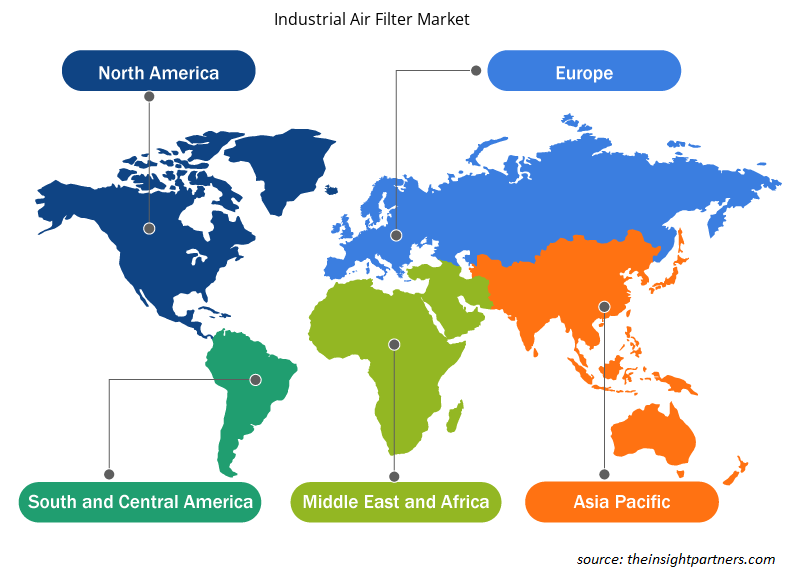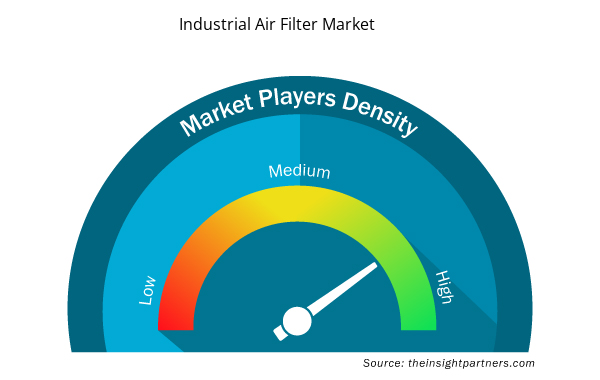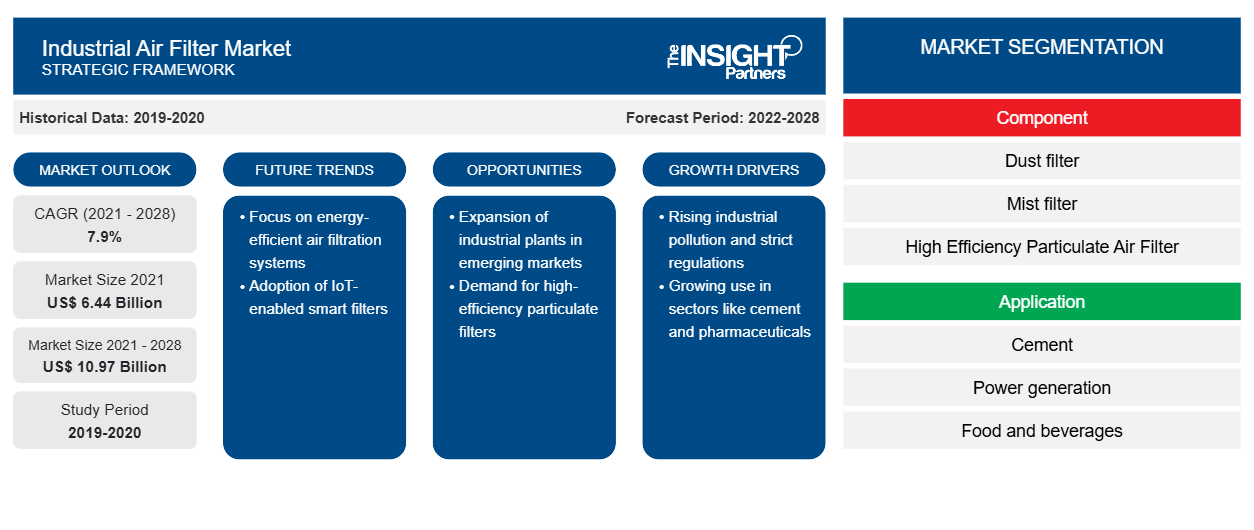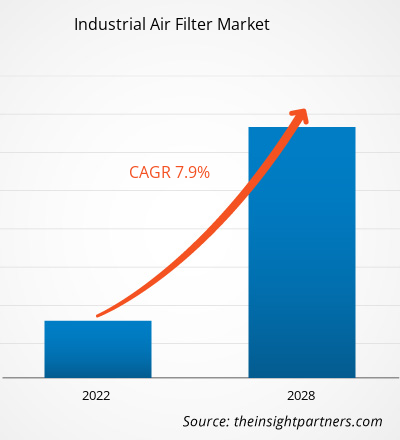[研究报告] 工业空气过滤器市场预计将从 2021 年的 64.4 亿美元增长到 2028 年的 109.7 亿美元;预计 2021-2028 年期间的复合年增长率为 7.9%。
分析师观点:
近年来,工业空气过滤器市场大幅增长并不断扩大。这可以归因于几个关键因素,这些因素推动了工业环境中对空气过滤系统的需求。主要驱动因素之一是全球各个行业的快速工业化步伐。随着工业扩张和生产过程的强化,空气中的污染物和污染物也随之增加。这就需要实施有效的空气过滤系统,以保持最佳空气质量并保护工人的健康。另一个促成市场增长的重要因素是政府和环保机构的空气质量标准和法规越来越严格。这些法规旨在最大限度地减少工业运营向大气中排放的污染物。因此,各行业被迫投资先进的空气过滤技术,以符合这些严格的标准。
此外,工业利益相关者越来越意识到空气质量差对生产力、工人福祉和整体运营效率的不利影响。工业空气过滤器在去除空气中的有害颗粒(如灰尘、烟雾、化学物质和过敏原)方面发挥着至关重要的作用,从而创造更健康、更安全的工作环境。工业空气过滤器市场涵盖各种产品,满足制造业、汽车业、制药业、食品加工、化工厂和电子业等不同工业部门的需求。这些过滤器的尺寸、效率和技术各不相同,具体取决于每个行业的具体要求。
市场概况:
为了提高室内和室外空气的质量,空气过滤器可以减少或去除空气中的杂质。任何供暖、通风和空调系统都需要工业空气过滤器来去除空气中的异物。工业空气过滤器对于任何会产生烟雾和污染物的企业来说都至关重要。这些过滤器通过过滤掉花粉、灰尘和化学污染物等污染物来维持封闭环境中的室内空气质量 (IAQ)。工业空气过滤器还可以防止污染物进入工业机械,从而降低大型异物损坏机器的风险。
定制此报告以满足您的需求
您可以免费定制任何报告,包括本报告的部分内容、国家级分析、Excel 数据包,以及为初创企业和大学提供优惠和折扣
- 获取此报告的关键市场趋势。这个免费样品将包括数据分析,从市场趋势到估计和预测。
市场驱动因素:
健康和安全意识的增强推动工业空气过滤器市场的增长
工业环境中对健康和安全的意识日益增强,在推动工业空气过滤器市场增长方面发挥着重要作用。随着组织和行业越来越意识到空气质量对工人健康和安全的影响,他们更加重视创造清洁健康的室内环境。这种意识导致对有效空气过滤系统的需求增加,从而推动了市场增长。组织优先考虑员工的健康,认识到空气质量差会导致呼吸问题、过敏和职业病。通过投资高质量的空气过滤系统,公司旨在改善室内空气质量并为员工提供安全的工作环境。对工人健康的关注推动了对工业空气过滤器的需求,促进了市场增长。
政府和监管机构制定了严格的职业健康和安全法规。这些法规通常包括在工业环境中保持可接受的空气质量标准的具体要求。组织必须遵守这些法规,以避免受到处罚和承担法律责任。对有效的空气过滤系统的需求日益增长,以满足这些合规要求,从而进一步推动了市场增长。清洁健康的室内空气质量也直接影响工人的生产力和整体运营效率。当员工接触到洁净的空气时,他们的健康问题会减少,疲劳感会减轻,注意力和专注力也会提高。认识到这一点,组织投资于工业空气过滤器以优化员工的绩效,最终提高生产力和运营效率。
此外,优先考虑员工健康和安全的组织可以建立积极的声誉和品牌形象。消费者、投资者和人才越来越倾向于支持致力于工人福祉和环境可持续性的企业。通过投资先进的空气过滤系统来提供清洁健康的工作环境,公司可以提高声誉并在市场上获得竞争优势。工业环境中对健康和安全的认识不断提高也反映了消费者偏好的变化。消费者现在更加注重他们购买的产品和他们支持的公司。他们更喜欢优先考虑工人福祉和环境责任的企业。因此,致力于通过工业空气过滤器提供清洁健康空气质量的组织可以与这些消费者偏好保持一致,在市场上占据有利地位。
节段分析:
根据产品,工业空气过滤器市场分为除尘过滤器、雾过滤器、袋式过滤器、滤筒式集尘器和过滤器(CC 和 F)、高效空气微粒子过滤器、湿式洗涤器和干式洗涤器。湿式洗涤器部分在 2020 年占据了最大的市场份额,预计在预测期内将实现最高的复合年增长率。湿式洗涤器已成为工业空气过滤器市场的主导部分,原因有几个。它们具有高效的污染物去除能力、跨行业的多功能性以及符合严格的排放法规。湿式洗涤器可有效消除有害物质并控制颗粒物,使其成为各个工业部门的首选。技术进步、成本效益和长期利益进一步主导了它们的市场。总体而言,湿式洗涤器的全面污染物去除能力和广泛的应用确保了其作为工业空气过滤器市场领先解决方案的地位。
区域分析:
2021 年北美工业空气过滤器市场价值为 21 亿美元,预计到 2028 年将达到 345 万美元;预计在预测期内将以 7.4% 的复合年增长率增长。北美地区已成为工业空气过滤器行业的主导市场,这主要是由于几个关键因素促成了其领先地位。首先,北美以实施严格的环境法规而闻名,尤其是在美国和加拿大等国家。这些法规旨在控制和减少空气污染,改善空气质量并保护公众健康。北美的工业部门必须遵守这些严格的排放标准,这推动了对先进空气过滤技术的需求。该地区的公司优先遵守这些法规,从而提高了工业空气过滤器的采用率。其次,北美拥有发达而多样化的工业部门。北美的高度工业化和工业活动导致大量排放和污染物被释放到大气中。为了解决环境问题并保护工人健康,北美的工业界投资于先进的空气过滤系统。因此,该地区对工业空气过滤器的需求高于其他地区。
此外,北美还具有技术进步和创新的文化。该地区拥有强大的研发基础设施,能够不断开发尖端的空气过滤技术。北美制造商处于开发和商业化先进过滤解决方案的前沿,这些解决方案可提供高效率和更高性能。这种技术领先地位使北美公司具有竞争优势,并有助于该地区在工业空气过滤器市场占据主导地位。此外,人们对北美空气质量重要性的认识日益加深,这是推动工业空气过滤器采用率提高的驱动力。行业和个人都越来越认识到清洁空气对健康和环境的益处。这种认识的提高导致对空气过滤解决方案的需求增加,进一步推动了北美市场的增长。
关键球员分析:
工业空气过滤器市场分析包括霍尼韦尔国际公司、MANN+HUMMEL International GmbH & Co、Beko Technologies、Sentry Air Systems、Nordic Air Filteration A/S、唐纳森公司、Filtration Group Industrial、Pall Corporation、General Filter Italia 和 Camfil 等参与者。在工业空气过滤器参与者中,霍尼韦尔国际公司和唐纳森公司由于提供多样化的产品组合而位居前两位。
工业空气过滤器市场区域洞察
Insight Partners 的分析师已详尽解释了预测期内影响工业空气过滤器市场的区域趋势和因素。本节还讨论了北美、欧洲、亚太地区、中东和非洲以及南美和中美洲的工业空气过滤器市场细分和地理位置。

- 获取工业空气过滤器市场的区域具体数据
工业空气过滤器市场报告范围
| 报告属性 | 细节 |
|---|---|
| 2021 年市场规模 | 64.4 亿美元 |
| 2028 年市场规模 | 109.7亿美元 |
| 全球复合年增长率(2021 - 2028) | 7.9% |
| 史料 | 2019-2020 |
| 预测期 | 2022-2028 |
| 涵盖的领域 | 按组件
|
| 覆盖地区和国家 | 北美
|
| 市场领导者和主要公司简介 |
|
工业空气过滤器市场参与者密度:了解其对业务动态的影响
工业空气过滤器市场正在快速增长,这得益于最终用户需求的不断增长,这些需求源于消费者偏好的不断变化、技术进步以及对产品优势的认识不断提高等因素。随着需求的增加,企业正在扩大其产品范围,进行创新以满足消费者的需求,并利用新兴趋势,从而进一步推动市场增长。
市场参与者密度是指在特定市场或行业内运营的企业或公司的分布情况。它表明在给定市场空间中,相对于其规模或总市场价值,有多少竞争对手(市场参与者)存在。
在工业空气过滤器市场运营的主要公司有:
- 霍尼韦尔国际公司
- 曼胡默尔有限公司
- 北欧空气过滤
- 唐纳森公司
- 意大利通用过滤器
免责声明:上面列出的公司没有按照任何特定顺序排列。

- 了解工业空气过滤器市场顶级关键参与者概况
最新动态:
工业空气过滤器市场中的公司普遍采用并购等无机和有机战略。以下列出了一些近期的关键市场发展:
- 2021 年 11 月,阿法拉伐通过天然气燃烧装置 2.0 增强了其液化天然气产品组合。这项新投资将帮助该公司将其业务扩展到几个海湾国家。
- 2021 年 9 月,伊顿推出了一款新型零泄漏紧凑型组合阀,该阀通过堆叠加注限制通风阀 (FLVV) 和新型零泄漏级通风阀 (GVV),安全地排出油箱中的有害蒸发燃油蒸气
- 历史分析(2 年)、基准年、预测(7 年)及复合年增长率
- PEST 和 SWOT 分析
- 市场规模价值/数量 - 全球、区域、国家
- 行业和竞争格局
- Excel 数据集



Report Coverage
Revenue forecast, Company Analysis, Industry landscape, Growth factors, and Trends

Segment Covered
This text is related
to segments covered.

Regional Scope
North America, Europe, Asia Pacific, Middle East & Africa, South & Central America

Country Scope
This text is related
to country scope.
常见问题
This demand is mainly driven by an end-user preference for environmentally friendly air filters to reduce industrial workers' health risks. Manufacturers are increasingly creating energy-efficient air filters, such as rigid cellular filters, pleated filters, and pocket filters, that is both efficient and simple to install. Clarcor, for example, is a market participant that produces high-efficiency HVAC filters and antimicrobial filters that work in all climates. Furthermore, the rising desire for better environmental conditions in the residential and commercial sectors may present profitable prospects for the industrial air filter market. Furthermore, Camfil introduced the Absolute V, an energy-efficient HEPA air filter, in February 2020. It saves 20% of the energy used. Moreover, In April 2020, Parker presents an energy-efficient HVAC filter. HVAC systems for food processing, microelectronics production, clean manufacturing facilities, hospitals and healthcare facilities, and industrial manufacturing use Parker QuadSEAL 4 in filters. Thus, increasing demand for energy-efficient and higher-performing air filtration technologies is expected to propel the industrial air filter market forward.
on the basis of application the market is sub-segmented into cement, food and beverages, metals, power generation, pharmaceutical, chemical, oil and gas, others. The power generations segment led the industrial air filter market.
Based on product, the market is segmented as Dust Filters, Mist Filters, Baghouse Filters, Cartridge Collectors and Filters (CC and F), HEPA Filters, Wet Scrubbers, Dry Scrubbers. The dry scrubbers segment led the industrial air filter market with a market share of XX% in 2020. Further, it is expected to garner XX% share by 2028
With rising levels of air pollution worldwide, regulatory bodies have implemented various clean air regulations, prompting several sectors to integrate air filter units into their systems, which is a driving factor for market growth. Increased industrialization worldwide, such as in the cement, metal processing, pharmaceutical, and chemical industries, is another element driving expansion. Pollutants are also managed and monitored as a result of growing environmental concerns that promote business expansion. Over time, high capital investment works as a stifling factor for sector competitiveness. Production and installation of such components into the system is a costly event, which impedes the industries' expansion.
The key companies operating in the field of industrial air filter market that are profiled in the report include Honeywell International Inc, MANN+HUMMEL International GmbH & Co, Beko Technologies, Sentry Air Systems, Nordic Air Filteration A/S, Donaldson Company, Filtration Group Industrial, Pall Corporation, General Filter Italia, Camfil among many others.
Some of the most recent filtration advancements are based on new developments in filter design and media technology, fueled by legislative responses to climate change and rising GHG emissions. Filtration system designers and plant managers can now reduce their operating costs and save energy while maintaining the highest quality standards and achieving a performance boost thanks to innovative filtration products. There are numerous advancements in air filtering technologies for industrial uses, including automotive and other industrial applications, profiling breakthroughs such as Capaceon, NANOWEB, NanoWave, Synteq XP, PowerCore, and Ultra-Web. For instance, Donaldson, a prominent global provider of filtration systems and replacement parts, recently introduced Synteq XP compressed air filter media, which the firm claims boosts efficiency while decreasing energy consumption by as much as 40% due to a much lower media delta pressure. Furthermore, Hollingsworth & Vose Company designed and developed NanoWave, an all-synthetic extended surface, high-loft material that is environmentally friendly. The material has three times the dirt retention capacity of standard media and was designed for the ASHRAE (American Society of Heating, Refrigeration, and Air Conditioning Engineers)-certified HVAC bag filter media market. Delta pressure levels are projected to fall more in the coming years as filtering efficiency is required. The pressure to satisfy increased environmental demands develops, and new inventions, such as advancements in nanotechnology, are introduced to the market. Moreover, inhibited oxidation, for instance, has various advantages in wet scrubbers, including low reagent cost, reduced reagent usage, and low overall life cycle cost. In the suppressed oxidation process, emulsified sulphur is added to the reagent feed tank, lowering the oxidation rate to less than 15% and permitting the use of less expensive materials by removing the corrosion mechanism. Thus, the market for industrial air filter is expected to be driven by such advanced technologies and tools.
Trends and growth analysis reports related to Manufacturing and Construction : READ MORE..
The List of Companies - Industrial Air Filter Market
- Honeywell International, Inc.
- Mann + Hummel GmbH
- NORDIC AIR FILTRATION
- Donaldson Company, Inc
- GENERAL FILTER ITALIA
- Camfil AB
- Paul Corporation
- FILTRATION GROUP INDUSTRIAL
- SENTRY AIR SYSTEMS, INC
- AIR FILTERS, INC.
The Insight Partners performs research in 4 major stages: Data Collection & Secondary Research, Primary Research, Data Analysis and Data Triangulation & Final Review.
- Data Collection and Secondary Research:
As a market research and consulting firm operating from a decade, we have published and advised several client across the globe. First step for any study will start with an assessment of currently available data and insights from existing reports. Further, historical and current market information is collected from Investor Presentations, Annual Reports, SEC Filings, etc., and other information related to company’s performance and market positioning are gathered from Paid Databases (Factiva, Hoovers, and Reuters) and various other publications available in public domain.
Several associations trade associates, technical forums, institutes, societies and organization are accessed to gain technical as well as market related insights through their publications such as research papers, blogs and press releases related to the studies are referred to get cues about the market. Further, white papers, journals, magazines, and other news articles published in last 3 years are scrutinized and analyzed to understand the current market trends.
- Primary Research:
The primarily interview analysis comprise of data obtained from industry participants interview and answers to survey questions gathered by in-house primary team.
For primary research, interviews are conducted with industry experts/CEOs/Marketing Managers/VPs/Subject Matter Experts from both demand and supply side to get a 360-degree view of the market. The primary team conducts several interviews based on the complexity of the markets to understand the various market trends and dynamics which makes research more credible and precise.
A typical research interview fulfils the following functions:
- Provides first-hand information on the market size, market trends, growth trends, competitive landscape, and outlook
- Validates and strengthens in-house secondary research findings
- Develops the analysis team’s expertise and market understanding
Primary research involves email interactions and telephone interviews for each market, category, segment, and sub-segment across geographies. The participants who typically take part in such a process include, but are not limited to:
- Industry participants: VPs, business development managers, market intelligence managers and national sales managers
- Outside experts: Valuation experts, research analysts and key opinion leaders specializing in the electronics and semiconductor industry.
Below is the breakup of our primary respondents by company, designation, and region:

Once we receive the confirmation from primary research sources or primary respondents, we finalize the base year market estimation and forecast the data as per the macroeconomic and microeconomic factors assessed during data collection.
- Data Analysis:
Once data is validated through both secondary as well as primary respondents, we finalize the market estimations by hypothesis formulation and factor analysis at regional and country level.
- Macro-Economic Factor Analysis:
We analyse macroeconomic indicators such the gross domestic product (GDP), increase in the demand for goods and services across industries, technological advancement, regional economic growth, governmental policies, the influence of COVID-19, PEST analysis, and other aspects. This analysis aids in setting benchmarks for various nations/regions and approximating market splits. Additionally, the general trend of the aforementioned components aid in determining the market's development possibilities.
- Country Level Data:
Various factors that are especially aligned to the country are taken into account to determine the market size for a certain area and country, including the presence of vendors, such as headquarters and offices, the country's GDP, demand patterns, and industry growth. To comprehend the market dynamics for the nation, a number of growth variables, inhibitors, application areas, and current market trends are researched. The aforementioned elements aid in determining the country's overall market's growth potential.
- Company Profile:
The “Table of Contents” is formulated by listing and analyzing more than 25 - 30 companies operating in the market ecosystem across geographies. However, we profile only 10 companies as a standard practice in our syndicate reports. These 10 companies comprise leading, emerging, and regional players. Nonetheless, our analysis is not restricted to the 10 listed companies, we also analyze other companies present in the market to develop a holistic view and understand the prevailing trends. The “Company Profiles” section in the report covers key facts, business description, products & services, financial information, SWOT analysis, and key developments. The financial information presented is extracted from the annual reports and official documents of the publicly listed companies. Upon collecting the information for the sections of respective companies, we verify them via various primary sources and then compile the data in respective company profiles. The company level information helps us in deriving the base number as well as in forecasting the market size.
- Developing Base Number:
Aggregation of sales statistics (2020-2022) and macro-economic factor, and other secondary and primary research insights are utilized to arrive at base number and related market shares for 2022. The data gaps are identified in this step and relevant market data is analyzed, collected from paid primary interviews or databases. On finalizing the base year market size, forecasts are developed on the basis of macro-economic, industry and market growth factors and company level analysis.
- Data Triangulation and Final Review:
The market findings and base year market size calculations are validated from supply as well as demand side. Demand side validations are based on macro-economic factor analysis and benchmarks for respective regions and countries. In case of supply side validations, revenues of major companies are estimated (in case not available) based on industry benchmark, approximate number of employees, product portfolio, and primary interviews revenues are gathered. Further revenue from target product/service segment is assessed to avoid overshooting of market statistics. In case of heavy deviations between supply and demand side values, all thes steps are repeated to achieve synchronization.
We follow an iterative model, wherein we share our research findings with Subject Matter Experts (SME’s) and Key Opinion Leaders (KOLs) until consensus view of the market is not formulated – this model negates any drastic deviation in the opinions of experts. Only validated and universally acceptable research findings are quoted in our reports.
We have important check points that we use to validate our research findings – which we call – data triangulation, where we validate the information, we generate from secondary sources with primary interviews and then we re-validate with our internal data bases and Subject matter experts. This comprehensive model enables us to deliver high quality, reliable data in shortest possible time.


 获取此报告的免费样本
获取此报告的免费样本